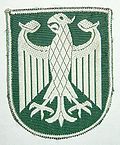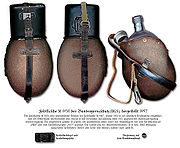
Bundesgrenzschutz
Encyclopedia

Western Germany
The geographic term Western Germany is used to describe a region in the west of Germany. The exact area defined by the term is not constant, but it usually includes, but does not have the borders of, North Rhine-Westphalia and Hesse...
after World War II
World War II
World War II, or the Second World War , was a global conflict lasting from 1939 to 1945, involving most of the world's nations—including all of the great powers—eventually forming two opposing military alliances: the Allies and the Axis...
permitted by the Allied occupation authorities. In July 2005, the BGS was renamed Bundespolizei (Federal Police) to reflect its transition to a multi-faceted police agency.
It was established in 1951. In these years there were frequent incidents on the borders with East Germany and Czechoslovakia
Czechoslovakia
Czechoslovakia or Czecho-Slovakia was a sovereign state in Central Europe which existed from October 1918, when it declared its independence from the Austro-Hungarian Empire, until 1992...
, and the occupation authorities became convinced of the need for a competent border police. The BGS was organized along paramilitary lines in battalions, companies, and platoons, and was armed as light infantry. It remained a police force controlled by the Ministry of Interior
Federal Ministry of the Interior (Germany)
The Federal Ministry of the Interior is a ministry of the German federal government. Its main office is in Berlin, with a secondary seat in Bonn. The current minister of the interior is Dr...
rather than by the Ministry of Defense
Federal Ministry of Defence (Germany)
The Federal Ministry of Defence is a top-level federal agency, headed by the Federal Minister of Defence as a member of the Cabinet of Germany...
.
On 03/10/1953 The Bundespasskontrolldienst (passport control service) was transferred to the BGS and was now deployed on the entire German border.
In 1972 the BGS became responsible for the security of the Federal Constitutional Court, the Bundespräsidenten (Federal President), the Bundeskanzler (Federal Chancellor), the Foreign Office and the Federal Ministry of the Interior. On 1 January 1974 the BGS became an all volunteer force and in 1987 started recruiting women.
On 1 June 1990 saw the elimination of border patrols and control of persons at the Inner-German border.
The strength of the BGS was 24,000 in early 1995. The BGS is equipped with armored cars, machine guns, automatic rifles, tear gas, hand grenades, rifle grenades, and antitank weapons. All personnel on border and security duty wore sidearms. Five units had light aircraft and helicopters to facilitate rapid access to remote border areas and for patrol and rescue missions.

Coast guard
A coast guard or coastguard is a national organization responsible for various services at sea. However the term implies widely different responsibilities in different countries, from being a heavily armed military force with customs and security duties to being a volunteer organization tasked with...
force called the Bundesgrenzschutz-See, as part of the Koordinierungsverbund Küstenwache
German Federal Coast Guard
The German Federal Coast Guard is a civilian law enforcement organisation whose primary missions are border protection, maritime environmental protection, shipping safety, fishery protection and customs enforcement...
or Coast Watch, was founded 7 January 1951 an consisted of approximately 550 members formed part of the BGS. It was equipped with fourteen large patrol craft and several helicopters.
In addition to controlling Germany's border, the BGS Alert police served as a federal reserve force to deal with major disturbances and other emergencies beyond the scope of Land police. The BGS guarded airports and foreign embassies, and several highly trained detachments are available for special crisis situations requiring demolition equipment, helicopters, or combat vehicles.
After shortcomings in police procedures and training were revealed by the terrorist attack on Israeli athletes at the 1972 Summer Olympics
1972 Summer Olympics
The 1972 Summer Olympics, officially known as the Games of the XX Olympiad, were an international multi-sport event held in Munich, West Germany, from August 26 to September 11, 1972....
, a BGS task force known as Special Group 9 (GSG-9) was formed to deal with terrorist incidents, especially hostage situations. The BGS-9 won world attention when it rescued eighty-six passengers on a Lufthansa
Lufthansa
Deutsche Lufthansa AG is the flag carrier of Germany and the largest airline in Europe in terms of overall passengers carried. The name of the company is derived from Luft , and Hansa .The airline is the world's fourth-largest airline in terms of overall passengers carried, operating...
Flight 181
Lufthansa Flight 181
Lufthansa Flight 181 was a Lufthansa Boeing 737-230 Adv aircraft named Landshut that was hijacked on October 13, 1977 by four members of the Popular Front for the Liberation of Palestine...
airliner which was hijacked to Mogadishu
Mogadishu
Mogadishu , popularly known as Xamar, is the largest city in Somalia and the nation's capital. Located in the coastal Benadir region on the Indian Ocean, the city has served as an important port for centuries....
, Somalia
Somalia
Somalia , officially the Somali Republic and formerly known as the Somali Democratic Republic under Socialist rule, is a country located in the Horn of Africa. Since the outbreak of the Somali Civil War in 1991 there has been no central government control over most of the country's territory...
, in 1977.


Bundeswehr
The Bundeswehr consists of the unified armed forces of Germany and their civil administration and procurement authorities...
was replaced in the mid-1970s by civil service-type personnel grades. The service uniform is green, but field units did wear camouflage fatigues and, at times, steel helmets.
The West German Railway Police (Bahnpolizei
Bahnpolizei
Bahnpolizei is the term in Germany, Austria and the German-speaking parts of Switzerland for the Railway police.-Germany:Bahnpolizei was the name of the former Railway police of West Germany and fell under the jurisdiction of the Deutsche Bundesbahn federal railway company...
), formerly an independent force, and the East German Transportpolizei
Transportpolizei
The Transportpolizei was the transit police of the German Democratic Republic , whose officers were commonly nicknamed TraPos. It was part of the Volkspolizei and dealt with all modes of transit but primarily with trains and railroads...
were restructured under the BGS in 1990.
See also
- GrepoGrepoGrepo is the short form of the German word for border police . It is usually found in English referring to the Grenztruppen der DDR who guarded the inner German border and the Berlin Wall, but can be used to refer to other border police, such as the former Bayerische Grenzpolizei , and the...
- Crossing the inner German borderCrossing the inner German borderCrossing the inner German border remained possible throughout the Cold War; it was never entirely sealed in the fashion of the border between the two Koreas, though there were severe restrictions on the movement of East German citizens...
- Development of the inner German borderDevelopment of the inner German borderThe development of the inner German border took place in a number of stages between 1945 and the mid-1980s. After its establishment in 1945 as the dividing line between the Western and Soviet occupation zones of Germany, in 1949 the inner German border became the frontier between the Federal...
- Fortifications of the inner German borderFortifications of the inner German borderThe fortifications of the inner German border comprised a complex system of interlocking fortifications and security zones long and several kilometres deep, running from the Baltic Sea to Czechoslovakia...
- Escape attempts and victims of the inner German borderEscape attempts and victims of the inner German borderThere were numerous escape attempts and victims of the inner German border during its 45 years of existence from 1945 to 1990.-Refugee flows and escape attempts:...
- Fall of the inner German borderFall of the inner German borderThe fall of the inner German border came rapidly and unexpectedly in November 1989, along with the fall of the Berlin Wall. The event paved the way for the ultimate reunification of Germany just short of a year later....
External links
- Bundespolizei home page (in German)
- Historic Uniforms of the BGS, first camouflage, second camouflage und third camouflage pattern
- Information brochure about the Bundespolizei (in German and English) last updated August 2005
- (in German) - You can see the old Bundesgrenzschutz in historic pictures and films and you can listen songs of the Bundesgrenzschutz
German language pages on the BGS:
- BPOL BGS History page
- http://www.beim-alten-bgs.de
- http://www.bgs-erinnerung.de
- http://www.grenzstreife.de
- Die Mowag-Sonderwagen des BGS

